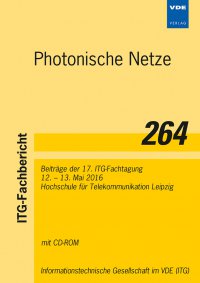First 20 Gbit/s Burst-Mode OOK Upstream with Direct Modulated Laser over up to 50km Single Mode Fiber
Conference: Photonische Netze - 17. ITG-Fachtagung
05/12/2016 - 05/13/2016 at Leipzig, Deutschland
Proceedings: Photonische Netze
Pages: 4Language: englishTyp: PDF
Personal VDE Members are entitled to a 10% discount on this title
Authors:
Poehlmann, W.; Schmuck, H.; Bonk, R.; Pfeiffer, Th. (Nokia, Bell Labs, Lorenzstr. 10, 70435 Stuttgart, Germany)
Abstract:
Burst-mode transmitters (Tx) for the upstream of time-division multiplexed passive optical networks (TDM-PON) are very cost sensitive, because they are employed in every optical network unit (ONU) at the customer premise. This can be located at a distance of up to 40 km from the central office. Bit rates of 10 Gbit/s and beyond are currently discussed for the next-generation of TDM-PON networks. The state of the art Tx for these bit rates is expensive, because it consists of a distributed feedback laser (DFB), an electro-absorption modulator (EAM) and e.g. a semiconductor optical amplifier (SOA). Burst-mode operation of this Tx is possible by either switching off the EAM or the SOA. Contrary, the use of DML at higher speed is limited by the achievable fiber reach to about 5 km at 20 Gbit/s mainly because of the laser-induced chirp. Therefore, we present for the first time a cost efficient solution using a direct modulated DFB laser that offers 20 Gbit/s burst-mode operation with transmission exceeding 50 km by experiments. We solved the issue of typical chirp-limited DML by applying a method that combines amplitude and frequency contributions of the laser. This concept is comparable to the method of dispersion supported transmission (DST) that has been used to extend the fiber reach of continu-ously operated lasers but it was never applied to burst-mode operation. In our 20Gbit/s experiment we achieved 32.2 dB loss budget, compared continuous and burst-mode operation and investigated the influence from different fiber lengths with bit-error ratio measurements. We are even able to handle the burst time dependant Tx wavelength-drift causing an increased spectral width together with a decreased fiber dispersion tolerance. This materializes in an induced fiber length and burst time dependant phase shift for the received signal, what was mitigated in the experiment by a time controlled sampling clock phase shifter.


